Popular categories
Looking for a yarn?
Order DROPS Needles & Hooks
Clicking the ORDER button will redirect you to Wool Warehouse Direct Ltd website
The yarn cost is calculated from the pattern’s smallest size and the yarn’s cheapest product type. Looking for an even better price? You might find it on the DROPS Deals!
Spice Market
Knitted jumper in DROPS Sky. Piece is knitted top down with raglan, textured pattern and vents in the sides. Size: S - XXXL
DROPS design: Pattern sk-170
Yarn group B
----------------------------------------------------------
SIZE:
S - M - L - XL - XXL - XXXL
MATERIALS:
DROPS SKY from Garnstudio (belongs to yarn group B)
300-350-400-400-450-500 g colour 11, hazelnut
NEEDLES:
DROPS CIRCULAR NEEDLE SIZE 4.5 mm: Length 40 and 80 cm.
DROPS CIRCULAR NEEDLE SIZE 3.5 mm: Length 40 and 80 cm
DROPS DOUBLE POINTED NEEDLES SIZE 4.5 mm
DROPS DOUBLE POINTED NEEDLES SIZE 3.5 mm
The technique MAGIC LOOP can be used – you then only need circular needle of 80 cm in each size.
KNITTING TENSION:
20 stitches in width and 26 rows vertically in stocking stitch = 10 x 10 cm.
NOTE! Remember that needle size is only a suggestion. If you have too many stitches on 10 cm switch to larger needles. If you have too few stitches on 10 cm switch to smaller needles.
-------------------------------------------------------
Alternative Yarn – See how to change yarns here
Yarn Groups A to F – Use the same pattern and change the yarn here
Yarn usage using an alternative yarn – Use our yarn converter here
-------------------------------------------------------
Women Jumpers Basic Jumpersassembly free double neck raglan round neck stocking stitch top down
Order DROPS Needles & Hooks
Clicking the ORDER button will redirect you to Wool Warehouse Direct Ltd website
The yarn cost is calculated from the pattern’s smallest size and the yarn’s cheapest product type. Looking for an even better price? You might find it on the DROPS Deals!
- English (UK/cm)
- Česky
- Dansk
- Deutsch
- Eesti keel
- English (US/in)
- Español
- Français
- Íslenska
- Italiano
- Magyar
- Nederlands
- Norsk
- Polski
- Português
- Suomi
- Svenska
- English (UK/cm), Bulgaria
- English (UK/cm), Croatia
- English (UK/cm), Greece
- English (UK/cm), Latvia
- English (UK/cm), Lithuania
- English (UK/cm), Romania
- English (UK/cm), Slovenia
- Česky, Slovakia
Pattern instructions
EXPLANATION FOR THE PATTERN:
----------------------------------------------------------
GARTER STITCH (back and forth):
Knit all rows.
1 ridge vertically = knit 2 rows.
PATTERN:
See diagrams A.1 to A.3. Choose diagram for your size in A.1 and A.3.
RAGLAN:
Increase 1 stitch before/after marker threads on sleeves as follows: Work until first marker thread on sleeve stitches (marker thread is here), knit 1, make 1 yarn over, work until 1 stitch before next marker thread, make 1 yarn over, knit 1 (marker thread is here). Repeat on the other sleeve (= 4 stitches increased on sleeves). On next round knit yarn overs twisted to avoid holes. Then work the new stitches in stocking stitch.
DECREASE TIP (applies to sleeves):
Decrease 1 stitch on each side of marker thread: Work until 3 stitches remain before marker thread and knit 2 together, knit 2 (marker thread is between these 2 stitches), slip 1 stitch knitwise, knit 1, pass slipped stitch over stitch worked.
----------------------------------------------------------
START THE PIECE HERE:
----------------------------------------------------------
JUMPER - SHORT OVERVIEW OF THE PIECE:
Double neck edge and yoke are worked in the round on circular needle top down. Work body in the round down to vent in the sides, then finish front piece and back back and forth on circular needle separately. Work sleeves in the round on a short circular needle/double pointed needles.
DOUBLE NECK EDGE:
Cast on 118-122-128-132-138-142 stitches with DROPS Sky over a short circular needle size 4.5 and a short circular needle size 3.5 mm held together.
Pull out circular 4.5 mm and keep stitches on the short circular needle size 3.5 mm (cast is done like this to get an elastic cast-on edge). Knit 1 round, then work rib (knit 1/purl 1). Work rib for 14 cm. Now fold the rib inwards to form a double edge - then work next round in rib as before at the same time work every other stitch together with every other stitch from cast-on edge. You now have a double neck edge. Insert 1 marker in the middle of round (mid front) – measure yoke from this marker.
YOKE:
Switch to circular needle size 4.5 mm, knit 1 round while decreasing 26-26-28-28-30-30 stitches evenly = 92-96-100-104-108-112 stitches. Then work as follows:
* A.1, A.2, A.3, insert 1 marker thread here (back piece/front piece), knit 1, make 1 yarn over, knit 11-13-15-9-11-13, make 1 yarn over, knit 1, insert a marker thread here (sleeve) *, work from *-* 1 more time on round. 1 stitch for RAGLAN has now been increased – read explanation above, in each side of sleeve and 1 stitch has been increased on A.1/A.3 on front piece and back piece = 100-104-108-112-116-120 stitches. REMEMBER THE KNITTING TENSION!
Continue in the round with pattern as follows and increase for raglan on sleeves every other round 21-25-26-31-31-30 more times (22-26-27-32-32-31 times in total), AT THE SAME TIME when diagrams have been worked vertically, repeat the last 2 rounds vertically in each diagram vertically 20-23-27-28-33-36 more times (i.e. increase 1 stitch on each side of A.2 until there are 55-61-69-71-81-87 stitches in stocking stitch between A.1 and A.3 on back piece and front piece) = 284-316-340-368-392-404 stitches.
Then continue with texture over the 15-15-15-19-19-19 stitches in A.1 and A.3, and stocking stitch over the remaining stitches until piece measures 22-24-26-28-30-32 cm measured from marker and down to mid front. Work next round as follows: Work pattern as before over the first 85-91-99-109-119-125 stitches (back piece), slip the next 57-67-71-75-77-77 stitches on a thread (sleeve), cast on 10-10-10-12-12-16 stitches on needle (in the side under sleeve), work the next 85-91-99-109-119-125 stitches (front piece), slip the next 57-67-71-75-77-77 stitches on a thread (sleeve), cast on 10-10-10-12-12-16 new stitches in the side under sleeve. NOW MEASURE PIECE FROM HERE!
BODY:
= 190-202-218-242-262-282 stitches. Insert a marker thread in each side on body, in the middle of the new stitches cast-on in the side under the sleeves (= 5-5-5-6-6-8 new stitches on each side of marker thread). Work pattern as before over stitches in A.1 and A.3, work the remaining stitches on round in stocking stitch. When piece measures 22 cm in all sizes, work until marker thread in one side of piece. Then work back and forth over half the stitches on round for front/back piece, so make a vent in each side.
BACK PIECE:
= 95-101-109-121-131-141 stitches. Knit 1 row from right side while increasing 24-24-28-28-32-38 stitches evenly = 119-125-137-149-163-179 stitches. Switch to circular needle size 3.5 mm. Work rib as follows – from wrong side: 2 edge stitches in GARTER STITCH - read explanation above, * purl 1, knit 1 *, repeat from *-* until 3 stitches remain, purl 1 and 2 edge stitches in garter stitch. When piece measures 8 cm, cast off. Jumper measures approx. 56-58-60-62-64-66 cm from shoulder and down.
FRONT PIECE:
Work as on back piece.
SLEEVE:
Slip the 57-67-71-75-77-77 stitches from thread in one side of piece on a short circular needle/double pointed needles size 4.5 mm and pick in addition up 1 stitch in each of the 10-10-10-12-12-16 stitches cast on under sleeve = 67-77-81-87-89-93 stitches. Insert 1 marker thread in the middle of the new stitches under sleeve (= 5-5-5-6-6-8 new stitches on each side of marker thread). Work in stocking stitch in the round. When piece measures 4 cm from division, decrease 2 stitches mid under sleeve - read DECREASE TIP. Decrease like this every 7½-3½-3-2-2-2 cm 5-9-10-12-12-13 times in total. When all decreases are done, there are 57-59-61-63-65-67 stitches on round. Work until sleeve measures 37-35-34-32-31-29 cm from division. Knit 1 round while increasing 11 stitches evenly = 68-70-72-74-76-78 stitches. Switch to double pointed needles size 3.5 mm and work rib = knit 1/purl 1 for 4 cm. Cast off. Sleeve measures approx. 41-39-38-36-35-33 cm from division. Work the other sleeve the same way.
Diagram

|
= knit |

|
= purl |

|
= between 2 stitches make 1 yarn over, on next round knit yarn over twisted (to make avoid holes) |

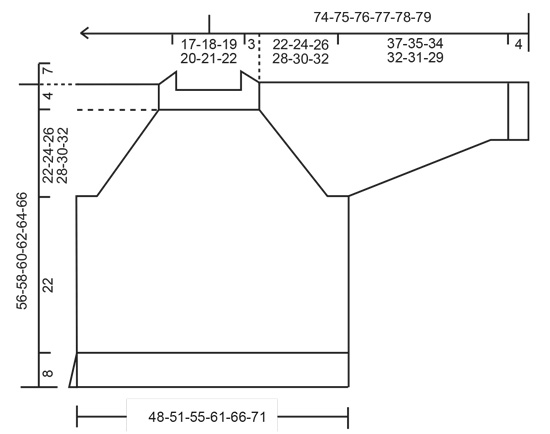
What can you do with our patterns? You can share DROPS patterns online, using the pattern original picture, materials, name and number. But you are NOT ALLOWED to reproduce the complete pattern digitally in any way. Yarn stores are welcome to use the DROPS pattern database to promote the sale of our assortment. You can print out our patterns, make as many copies as you’d like. The only thing we ask is that you don't make any changes / additions to the original printed document. And that the patterns according to the DROPS philosophy are given out to the consumers for free. Editorials that wish to publish our patterns in printed books or magazines can contact us for more information. The sale of garments based on DROPS patterns is permitted as long as they are sold as single items or per order. Further commercial use of the patterns is not permitted. It has to be clearly stated that the garment is made based on a design from DROPS DESIGN. The use of clothing labels of which DROPS DESIGN forms part is conditioned by the inclusion of the following text: “A DROPS DESIGN made by …..”. The use of DROPS photos for marketing purposes/sales is only permitted in connection with the use/sale of DROPS products. The photos may not be cut or edited and the logo should be clearly visible.
We reserve the right to withdraw the permission for use of our patterns at any time, notwithstanding the reason.
Each of our patterns has specific tutorial videos to help you.
These step-by-step tutorials might also help you:
Why is the knitting/crochet tension so important?
Knitting tension is what determines the final measurements of your work, and is usually measured per 10 x 10 cm. It is provided like so: number of stitches in width x number of rows in height - eg: 19 stitches x 26 rows = 10 x 10 cm.
The knitting tension is very individual; some people knit/crochet loosely while others work tightly. You adjust the knitting tension with the needle size, which is why the suggested needle size is only meant as a guide! You need to adjust this (up or down) to ensure that YOUR knitting tension matches the knitting tension provided in the pattern. If you work with a different knitting tension than provided you will have a different yarn consumption, and your work will have different measurements than what the pattern suggests.
The knitting tension also determines which yarns can replace each other. As long as you achieve the same knitting tension you can replace one yarn with another.
See DROPS lesson: How to measure your tension/gauge
See DROPS video: How to make a gauge tension swatch
How do I know how many balls of yarn I need?
The required amount of yarn is provided in grams, eg: 450 g. To calculate how many balls you’ll need you first need to know how many grams are in 1 ball (25g, 50g or 100g). This information is available if you click on the individual yarn quality on our pages. Divide the amount required with the amount of each ball. For example, if each ball is 50g (the most common amount), the calculation will be as follows: 450 / 50 = 9 balls.
Can I use a different yarn than what the pattern suggests?
The important thing when changing from one yarn to another is that the knitting/crochet tension remains the same. This is so that the measurements of the finished piece will be the same as on the sketch provided. It is easier to achieve the same knitting tension using yarns from the same yarn group. It is also possible to work with multiple strands of a thinner yarn to achieve the knitting tension of a thicker one. Please try our yarn converter. We recommend you to always work a test swatch.
Please NOTE: when changing yarn the garment might have a different look and feel to the garment in the photo, due to individual properties and qualities of each yarn.
See DROPS lesson: Can I use a different yarn than the one mentioned in the pattern?
What are the yarn groups?
All our yarns are categorised into yarn groups (from A to F) according to thickness and knitting tension – group A contains the thinnest yarns and group F the thickest. This makes it easier for you to find alternative yarns to our patterns, should you wish to switch yarn. All yarns within the same group have a similar knitting tension and can easily replace each other. However, different yarn qualities have different structures and properties which will give the finished work a unique look and feel.
How do I use the yarn calculator?
At the top of all our patterns you’ll find a link to our yarn calculator, which is a helpful tool should you wish to use a different yarn than suggested. By filling in the yarn quality you wish to replace, the amount (in your size) and number of strands, the calculator will present good alternative yarns with the same knitting tension. Additionally it will tell you how much you’ll require in the new qualities and whether you’ll need to work with multiple strands. Most skeins are 50g (some are 25g or 100g).
If the pattern is worked with multiple colours, every colour will have to be calculated separately. Similarly, if the pattern is worked with several strands of different yarns (for example 1 strand Alpaca and 1 strand Kid-Silk) you will have to find alternatives for each, individually.
Why do you show discontinued yarns in the patterns?
Since different yarns have different qualities and textures we have chosen to keep the original yarn in our patterns. However, you can easily find options among our available qualities by using our yarn calculator, or simply pick a yarn from the same yarn group.
It is possible that some retailers still have discontinued yarns in stock, or that someone has a few skeins at home that they would like to find patterns for.
The yarn calculator will provide both alternative yarn as well as required amount in the new quality.
What size should I knit?
If you think it's hard to decide what size to make, it can be a good idea to measure a garment you own already and like the size of. Then you can pick the size by comparing those measures with the ones available in the pattern's size chart.
You'll find the size chart at the bottom of the pattern.
See DROPS lesson: How to read size chart
Why do I get the wrong knitting tension with the suggested needle size?
The needle size provided in the pattern serves only as a guide, the important thing is to follow the knitting tension. And since knitting tension is very individual, you will have to adjust the needle size to ensure that YOUR tension is the same as in the pattern – maybe you’ll have to adjust 1, or even 2 needle sizes, up or down to achieve the correct tension. For this, we recommend that you work test swatches.
Should you work with a different knitting tension than the one provided, the measurements of the finished garment might deviate from the measurement sketch.
See DROPS lesson: How to measure your tension/gauge
See DROPS video: How to make a tension/gauge swatch
Why is the pattern worked top-down?
Working a garment top-down provides more flexibility and room for personal adjustment. For example it is easier to try the garment on while working, as well as making adjustments to length of yoke and shoulder caps.
The instructions are carefully explaining every step, in the correct order. Diagrams are adjusted to the knitting direction and are worked as usual.
How do I work according to a knitting diagram?
The diagram depicts all rows/rounds, and every stitch seen from the right side. It is read from bottom to top, from right to left. 1 square = 1 stitch.
When working back and forth, every other row is worked from the right side and every other row is worked from the wrong side. When working from the wrong side, the diagram will have to be worked reversed: from left to right, knit stitches are purled, purl stitches are knit etc.
When working in the round every round is worked from the right side and the diagram are worked from right to left on all rounds.
See DROPS lesson: How to read knitting diagrams
How do I work according to a crochet diagram?
The diagram depicts all rows/rounds, and every stitch seen from the right side. It is worked from bottom to top, from right to left.
When working back and forth every other row is worked from the right side: from right to left and every other row is worked from the wrong side: from left to right.
When working in the round, every row in the diagram are worked from the right side, from right to left.
When working a circular diagram you start in the middle and work your way outwards, counter clockwise, row by row.
The rows usually start with a given number of chain stitches (equivalent to the height of the following stitch), this will either be depicted in the diagram or explained in the pattern.
See DROPS lesson: How to read crochet diagrams
How do I work several diagrams simultaneously on the same row/round?
Instructions for working several diagrams after each other on the same row/round, will often be written like so: “work A.1, A.2, A.3 a total of 0-0-2-3-4 times". This means you work A.1 once, then A.2 is worked once, and A.3 is repeated (in width) the number of times provided for your size – in this case like so: S = 0 times, M = 0 times, L=2 times, XL= 3 times and XXL = 4 times.
The diagrams are worked as usual: begin with the first row in A.1, then work the first row in A.2 etc.
See DROPS lesson: How to read knitting diagrams
See DROPS lesson: How to read crochet diagrams
Why are the sleeves shorter in larger sizes?
The total width of the garment (from wrist-to-wrist) will be larger in the larger sizes, despite the actual sleeves being shorter. The larger sizes have longer sleeve caps and wider shoulders, so there will be a good fit in all sizes.
Where on the garment is the length measured?
The measurement sketch/schematic drawing provides information regarding the full length of the garment. If it’s a jumper or a jacket the length is measured from the highest point on the shoulder closest to the neckline, and straight down to the bottom of the garment. It is NOT measured from the tip of shoulder. Similarly, the length of yoke is measured from the highest point on the shoulder and down to where yoke is split into body and sleeves.
On a jacket measures are never taken along bands, unless specifically stated. Always measure inside band stitches when measuring the length.
See DROPS lesson: How to read a schematic drawing
What is a repeat?
Diagrams are often repeated on the round or in height. 1 repeat is the diagram the way it appears in the pattern. If it says to work 5 repeats of A.1 in the round, then you work A.1 a total of 5 times after/next to each other in the round. If it says to work 2 repeats of A.1 vertically/in height you work the entire diagram once, then begin again at the start and work the entire diagram one more time.
Why does the piece start with more chain stitches than it’s worked with?
Chain stitches are slightly narrower than other stitches and to avoid working the cast-on edge too tight, we simply chain more stitches to begin with. The stitch count will be adjusted on the following row to fit the pattern and measurement sketch.
Why increase before the rib edge when the piece is worked top-down?
The rib edge is more elastic and will contract slightly compared to, for example, stocking stitch. By increasing before the rib edge, you avoid a visible difference in width between the rib edge and the rest of the body.
Why increase in the cast-off edge?
It’s very easy to cast off too tightly, and by making yarn overs while casting off (and simultaneously casting these off) you avoid a too tight cast off edge.
See DROPS video: How to bind off with yarn overs (yo)
How do I increase/decrease on every 3rd and 4th row/round alternately?
To achieve an even increase (or decrease) you can increase on, for example: every 3rd and 4th row alternately, like so: work 2 rows and increase on the 3rd row, work 3 rows and increase on the 4th. Repeat this until the increase is complete.
See DROPS lesson: Increase or decrease 1 st on every 3rd and 4th row alternately
How can I work a jacket in the round instead of back and forth?
Should you prefer to work in the round instead of back and forth, you may of course adjust the pattern. You’ll need to add steeks mid-front (usually 5 stitches), and follow the instructions. When you would normally turn and work from the wrong side, simply work across the steek and continue in the round. At the end you’ll cut the piece open, pick up stitches to work bands, and cover the cut edges.
See DROPS video: How to knit steeks and cut open
Can I work a jumper back and forth instead of in the round?
Should you prefer to work back and forth instead of in the round, you may of course adjust the pattern so you work the pieces separately and then assemble them at the end. Divide the stitches for the body in 2, add 1 edge stitch in each side (for sewing) and work the front and back pieces separately.
See DROPS lesson: Can I adapt a pattern for circular needles into straight needles?
Why is the pattern slightly different than what I see in the photo?
Pattern repeats can vary slightly in the different sizes, in order to get the correct proportions. If you’re not working the exact same size as the garment in the photo, yours might deviate slightly. This has been carefully developed and adjusted so that the complete impression of the garment is the same in all sizes.
Make sure to follow instructions and diagrams for your size!
How do I make a women’s size garment into a men’s size one?
If you have found a pattern you like which is available in women’s size it’s not very difficult to convert it to men’s size. The biggest difference will be the length of sleeves and body. Start working on the women size that you think would fit across the chest. The additional length will be worked right before you cast off for the armhole/sleeve cap. If the pattern is worked top-down you can add the length right after the armhole or before the first decrease on sleeve.
Regarding additional yarn amount, this will depend on how much length you add, but it is better with a skein too many than too few.
How do I prevent a hairy garment from shedding?
All yarns will have excess fibres (from production) that might come off as lint or shedding. Brushed yarns (ie hairier yarns) have more of these loose, excess fibres, causing more shedding.
Shedding also depends on what is worn under or over the garment, and whether this pulls at the yarn fibres. It’s therefore not possible to guarantee that there will be no shedding
Below are some tips on how to get the best result when working with hairier yarns:
1. When the garment is finished (before you wash it) shake it vigorously so the looser hairs come off. NOTE: do NOT use a lint roller, brush or any method that pulls at the yarn.
2. Place the garment in a plastic bag and put it in your freezer - the temperature will cause the fibres to become less attached to each other, and excess fibres will come off easier.
3. Leave in the freezer for a few hours before taking it out and shaking it again.
4. Wash the garment according to the instructions on the yarn label.
Why does my garment pill?
Pilling is a natural process that happens to even the most exclusive of fibers. It's a natural sign of wear and tear that is hard to avoid, and that is most visible in high friction areas of your garment like a sweater's arms and cuffs.
You can make your garment look as new by removing the pilling, using a fabric comb or a pill/lint remover.
In the meantime, you can read the questions and answers that others have left to this pattern or join the DROPS Workshop on Facebook to get help from fellow knitters/crocheters!
You might also like...
Spice Market |
||||||||||
 |
 |
|||||||||
Knitted jumper in DROPS Sky. Piece is knitted top down with raglan, textured pattern and vents in the sides. Size: S - XXXL
DROPS 236-28 |
||||||||||
|
---------------------------------------------------------- EXPLANATION FOR THE PATTERN: ---------------------------------------------------------- GARTER STITCH (back and forth): Knit all rows. 1 ridge vertically = knit 2 rows. PATTERN: See diagrams A.1 to A.3. Choose diagram for your size in A.1 and A.3. RAGLAN: Increase 1 stitch before/after marker threads on sleeves as follows: Work until first marker thread on sleeve stitches (marker thread is here), knit 1, make 1 yarn over, work until 1 stitch before next marker thread, make 1 yarn over, knit 1 (marker thread is here). Repeat on the other sleeve (= 4 stitches increased on sleeves). On next round knit yarn overs twisted to avoid holes. Then work the new stitches in stocking stitch. DECREASE TIP (applies to sleeves): Decrease 1 stitch on each side of marker thread: Work until 3 stitches remain before marker thread and knit 2 together, knit 2 (marker thread is between these 2 stitches), slip 1 stitch knitwise, knit 1, pass slipped stitch over stitch worked. ---------------------------------------------------------- START THE PIECE HERE: ---------------------------------------------------------- JUMPER - SHORT OVERVIEW OF THE PIECE: Double neck edge and yoke are worked in the round on circular needle top down. Work body in the round down to vent in the sides, then finish front piece and back back and forth on circular needle separately. Work sleeves in the round on a short circular needle/double pointed needles. DOUBLE NECK EDGE: Cast on 118-122-128-132-138-142 stitches with DROPS Sky over a short circular needle size 4.5 and a short circular needle size 3.5 mm held together. Pull out circular 4.5 mm and keep stitches on the short circular needle size 3.5 mm (cast is done like this to get an elastic cast-on edge). Knit 1 round, then work rib (knit 1/purl 1). Work rib for 14 cm. Now fold the rib inwards to form a double edge - then work next round in rib as before at the same time work every other stitch together with every other stitch from cast-on edge. You now have a double neck edge. Insert 1 marker in the middle of round (mid front) – measure yoke from this marker. YOKE: Switch to circular needle size 4.5 mm, knit 1 round while decreasing 26-26-28-28-30-30 stitches evenly = 92-96-100-104-108-112 stitches. Then work as follows: * A.1, A.2, A.3, insert 1 marker thread here (back piece/front piece), knit 1, make 1 yarn over, knit 11-13-15-9-11-13, make 1 yarn over, knit 1, insert a marker thread here (sleeve) *, work from *-* 1 more time on round. 1 stitch for RAGLAN has now been increased – read explanation above, in each side of sleeve and 1 stitch has been increased on A.1/A.3 on front piece and back piece = 100-104-108-112-116-120 stitches. REMEMBER THE KNITTING TENSION! Continue in the round with pattern as follows and increase for raglan on sleeves every other round 21-25-26-31-31-30 more times (22-26-27-32-32-31 times in total), AT THE SAME TIME when diagrams have been worked vertically, repeat the last 2 rounds vertically in each diagram vertically 20-23-27-28-33-36 more times (i.e. increase 1 stitch on each side of A.2 until there are 55-61-69-71-81-87 stitches in stocking stitch between A.1 and A.3 on back piece and front piece) = 284-316-340-368-392-404 stitches. Then continue with texture over the 15-15-15-19-19-19 stitches in A.1 and A.3, and stocking stitch over the remaining stitches until piece measures 22-24-26-28-30-32 cm measured from marker and down to mid front. Work next round as follows: Work pattern as before over the first 85-91-99-109-119-125 stitches (back piece), slip the next 57-67-71-75-77-77 stitches on a thread (sleeve), cast on 10-10-10-12-12-16 stitches on needle (in the side under sleeve), work the next 85-91-99-109-119-125 stitches (front piece), slip the next 57-67-71-75-77-77 stitches on a thread (sleeve), cast on 10-10-10-12-12-16 new stitches in the side under sleeve. NOW MEASURE PIECE FROM HERE! BODY: = 190-202-218-242-262-282 stitches. Insert a marker thread in each side on body, in the middle of the new stitches cast-on in the side under the sleeves (= 5-5-5-6-6-8 new stitches on each side of marker thread). Work pattern as before over stitches in A.1 and A.3, work the remaining stitches on round in stocking stitch. When piece measures 22 cm in all sizes, work until marker thread in one side of piece. Then work back and forth over half the stitches on round for front/back piece, so make a vent in each side. BACK PIECE: = 95-101-109-121-131-141 stitches. Knit 1 row from right side while increasing 24-24-28-28-32-38 stitches evenly = 119-125-137-149-163-179 stitches. Switch to circular needle size 3.5 mm. Work rib as follows – from wrong side: 2 edge stitches in GARTER STITCH - read explanation above, * purl 1, knit 1 *, repeat from *-* until 3 stitches remain, purl 1 and 2 edge stitches in garter stitch. When piece measures 8 cm, cast off. Jumper measures approx. 56-58-60-62-64-66 cm from shoulder and down. FRONT PIECE: Work as on back piece. SLEEVE: Slip the 57-67-71-75-77-77 stitches from thread in one side of piece on a short circular needle/double pointed needles size 4.5 mm and pick in addition up 1 stitch in each of the 10-10-10-12-12-16 stitches cast on under sleeve = 67-77-81-87-89-93 stitches. Insert 1 marker thread in the middle of the new stitches under sleeve (= 5-5-5-6-6-8 new stitches on each side of marker thread). Work in stocking stitch in the round. When piece measures 4 cm from division, decrease 2 stitches mid under sleeve - read DECREASE TIP. Decrease like this every 7½-3½-3-2-2-2 cm 5-9-10-12-12-13 times in total. When all decreases are done, there are 57-59-61-63-65-67 stitches on round. Work until sleeve measures 37-35-34-32-31-29 cm from division. Knit 1 round while increasing 11 stitches evenly = 68-70-72-74-76-78 stitches. Switch to double pointed needles size 3.5 mm and work rib = knit 1/purl 1 for 4 cm. Cast off. Sleeve measures approx. 41-39-38-36-35-33 cm from division. Work the other sleeve the same way. |
||||||||||
Diagram explanations |
||||||||||
|
||||||||||

|
||||||||||

|
||||||||||
|
Have you made this or any other of our designs? Tag your pictures in social media with #dropsdesign so we can see them! Do you need help with this pattern?You'll find tutorial videos, a Comments/Questions area and more by visiting the pattern on garnstudio.com. © 1982-2024 DROPS Design A/S. We reserve all rights. This document, including all its sub-sections, has copyrights. Read more about what you can do with our patterns at the bottom of each pattern on our site. |
||||||||||
With over 40 years in knitting and crochet design, DROPS Design offers one of the most extensive collections of free patterns on the internet - translated to 17 languages. As of today we count 304 catalogues and 11422 patterns - 11422 of which are translated into English (UK/cm).
We work hard to bring you the best knitting and crochet have to offer, inspiration and advice as well as great quality yarns at incredible prices! Would you like to use our patterns for other than personal use? You can read what you are allowed to do in the Copyright text at the bottom of all our patterns. Happy crafting!







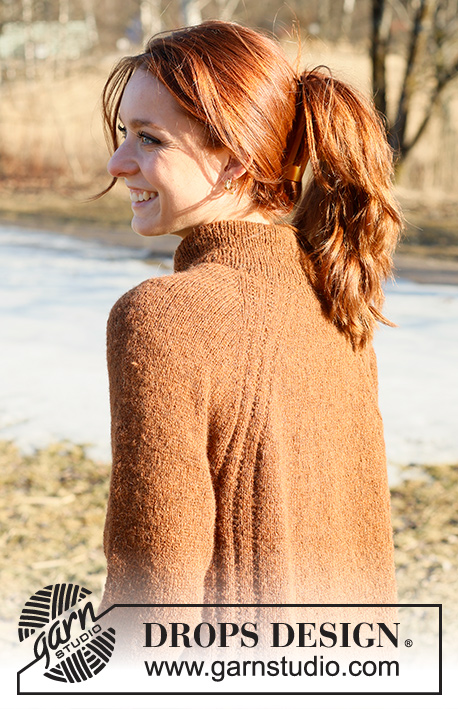



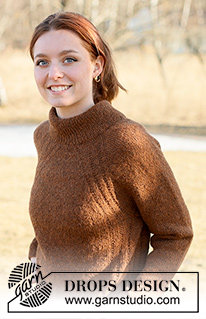
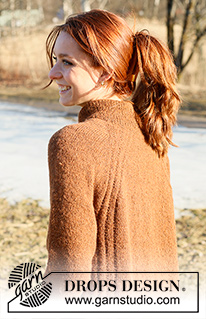

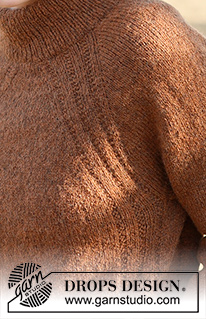












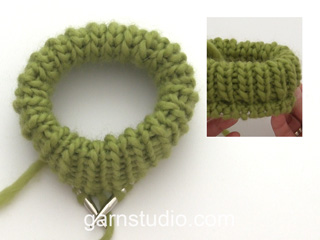





































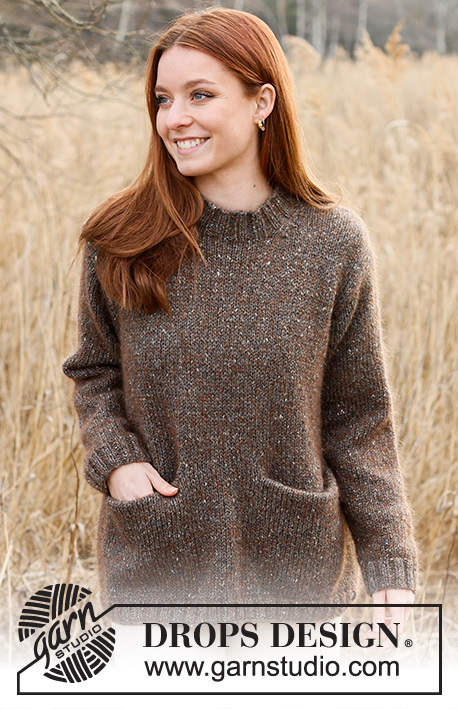







Comments / Questions (14)
Ciao, mi serve un chiarimento. Sto seguendo la taglia S, sono arrivata alle 284 maglie dello sprone, poi le istruzioni dicono "continuare fino ad avere 22 cm dal segnapunti al centro davanti." Si intende la diagonale che dal segnapunti dell' inizio del motivo va al centro del davanti alla base del collo ? In orizzontale non sono previsti aumenti quindi non possono aumentare i cm. Non mi è chiaro da dove a dove devo prendere questa misura.
10.09.2023 - 22:26DROPS Design answered:
Buonasera Agnese, abbiamo aggiornato il testo: deve misurare i 22 cm dal segnapunti inserito sul collo. Buon lavoro!
12.09.2023 - 19:44Hello, I'm confused about where the rounds begin and end on the yoke. After the first decrease round, it says to begin the next round with chart A1, A2, A3, which I understood to be the whole front/back motif. At the end of the neck it says to insert a marker in the middle of the round, at center front. But if you start the yoke round on one side of the front/back design, doesn't that mean that the beg./end of the round will then be in one of the raglan seams, rather then at center back?
31.08.2023 - 02:01DROPS Design answered:
Dear MK, the rounds start before back piece, just after the left sleeve (when garment is worn) and you increase for raglan as shown in A.1/A.3 on front and back piece and after the marker thread at the beginning of sleeve + before the marking thread at the end of sleeve - marker on mid front is to measure piece from. Happy knitting!
31.08.2023 - 09:38Hallo, stricke an der Passe und komme nicht auf die nötigen 284 Maschen (Gr. S). Habe entsprechend der Anleitung A1, A2,A3 im Diagramm einmal in der Höhe gestrickt und gleichzeitig die Raglanzunahmen an den Ärmeln in jeder 2. Runde gearbeitet. Aktuell sind es 140 Maschen auf der Rundnadel. Wenn ich nun weitere 20x die letzten zwei Runden der Diagramme wiederhole, sind es noch 80 Maschen die dazukommen – ein Total von 220 Maschen. Könnt Ihr mir hier bitte weiterhelfen? Danke!
20.06.2023 - 19:17DROPS Design answered:
Liebe Anna-Maria, für die Ärmel werden 22 Mal 4 Maschen (je 2 für jeden Ärmel) zugenommen (= 88 Maschen insgesamt) und beim Rumpfteil nehmen Sie zuerst 8 Maschen in A.1 (2 in jedem A.1/A.3) dann wird es 16 M in jedem A.2 zugenommen; und dann 20 Mal 4 Maschen (wie die 2 letzten Reihen A.2) = 8+16+80=104 Maschen insgesamt. Es waren 92 Maschen + 88 Zunahmen (Ärmel) +104 Zunahmen (Vorder- + Rückenteil) =284 Maschen. Viel Spaß beim stricken!
21.06.2023 - 08:01What is a marker thread? what purpose is it for ?
24.03.2023 - 01:52DROPS Design answered:
Dear Ann, this video shows how to place and use a marker thread; and this other video shows another way to use marker threads. They are used to mark areas and mark where to increase/decrease. Happy knitting!
24.03.2023 - 08:41Könnte man theoretisch die Halsblende direkt mit 100-104-108-112-116-120 Maschen stricken und dann bei Runde 3 des Diagramms einsteigen? Ich finde die Anleitung allgemein sehr schwer verständlich. Es ist nicht so ganz klar, wo denn der Rundenbeginn ist. Zwischen linkem Arm und dem Rücken? Oder doch an der vorderen Mitte, wo man den Markierungsfaden platzieren soll? Danke :-)
10.03.2023 - 13:58DROPS Design answered:
Liebe Frau Fuchs, am besten stricken Sie wie in der Anleitung, denn am Ende der 1. Runde mit A.1,A.2, A.3 beginnen schon die Zunahmen für die Passe, Runden beginnen am Anfang Rückenteil, von *bis* und das zweite Mal stricken Sie von *-* wieder wird das Vorderteil sein. Viel Spaß beim stricken!
10.03.2023 - 16:42Ik heb de hals dubbel gebreid, 7 cm, daarna de pas in patroon, 24 cm, maar op de tekening staat nog 4 cm tussen hals en pas. Ik begrijp niet waar die 4 cm voor staat, kunnen jullie helpen?
31.01.2023 - 21:44DROPS Design answered:
Dag Alma,
Je kunt gewoon de beschrijving aanhouden, dus 7 cm voor de hals en daarna 24 cm voor de pas. De 4 cm is denk ik vanaf de schouder tot het begin van de pas, wanneer je het werk plat neerlegt.
01.02.2023 - 20:27Ik heb de hals dubbel gebreid, 7 cm, daarna de pas in patroon, 24 cm, maar op de tekening staat nog 4 cm tussen hals en pas. Ik begrijp niet waar die 4 cm voor staat, kunnen jullie helpen?
31.01.2023 - 21:43Er der ikke fejl i cm angivelsen på ærmerne fra delingen skal ærmet være 29 cm - så når de kun til mine albuer
28.01.2023 - 11:51DROPS Design answered:
Hei Bettina. Plaggets vidde i str. xxxl skal tilsi at ermene fra deligen på 29 cm + 4 cm (vrangbord) er nok, men du kan fint strikke de lengre (om du har nok garn). Men prøv genseren på deg for å dobbeltsjekk lengden. mvh DROPS Design
30.01.2023 - 14:12På den danske udgave af opskriften er der ikke noget diagram. Har ledt højt og lavt, lukket den ned og genstartet, alt med samme resultat: ingen diagram. Ser jeg på den engelske udgave er der et diagram men usikker på om det er fyldestgørende
01.12.2022 - 16:59DROPS Design answered:
Hej Anette, jo når jeg går ind på den danske opskrift, både på computeren og på mobilen, så ligger diagrammerne nederst i opskriften - prøv med ctrl F5 igen :)
02.12.2022 - 08:36Jeg savner diagrammer til opskriften. Kommer ikke frem HJÆLP
30.11.2022 - 20:57DROPS Design answered:
Hej Anette, jo de skal være der, de ligger lige over måleskitsen nederst i opskriften :)
01.12.2022 - 13:52